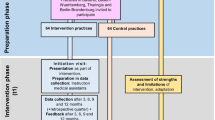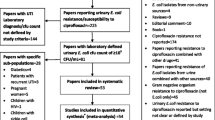Abstract
Guideline recommendations on empirical antibiotic treatment are based on the literature, expert opinion, expected pathogens and resistance data, but their adequacy in the real-life setting is often unknown. We investigated the adequacy of the Dutch evidence-based guideline-recommended treatment options for patients with complicated urinary tract infections (UTIs) 2 years after guideline publication and, additionally, the adequacy of actually prescribed empirical therapy for patients treated with guideline-adherent versus non-guideline-adherent therapy. A retrospective, observational multicentre study in the Netherlands included 810 patients with a complicated UTI without special conditions and 174 with a urinary catheter. The susceptibility patterns of cultured uropathogens were compared with guideline-recommended treatment options, which included specific recommendations for patients with a catheter, and with actually prescribed empirical therapy. We considered inadequate coverage rates below 10 % as acceptable. Of the recommended regimens for patients with a UTI without other conditions, only the guideline-recommended combination of amoxicillin–gentamicin was acceptable (inadequate coverage rate 6 %). For patients with a catheter, inadequate coverage rates of recommended regimens ranged from 3 to 24 %. In patients with a UTI without other conditions, actually prescribed guideline-adherent therapy resulted in less broad-spectrum but not in less adequate therapy; in patients with a catheter, actually prescribed guideline-adherent therapy resulted in a higher coverage rate than those prescribed non-guideline-adherent therapy. Due to the continuously changing resistance rates and differences between the epidemiologies of uropathogens assumed in the guideline and those in real life, regular real-life assessments of recommended treatment options are necessary. Guideline adherence seems to be effective for increasing coverage rates without prescribing unnecessarily broad regimens.




Similar content being viewed by others
References
Goossens H, Ferech M, Vander Stichele R, Elseviers M (2005) Outpatient antibiotic use in Europe and association with resistance: a cross-national database study. Lancet 365(9459):579–587
Fraser A, Paul M, Almanasreh N, Tacconelli E, Frank U, Cauda R et al (2006) Benefit of appropriate empirical antibiotic treatment: thirty-day mortality and duration of hospital stay. Am J Med 119(11):970–976
McGowan JE Jr (2001) Economic impact of antimicrobial resistance. Emerg Infect Dis 7(2):286–292
Tacconelli E (2009) Antimicrobial use: risk driver of multidrug resistant microorganisms in healthcare settings. Curr Opin Infect Dis 22(4):352–358
Cardoso T, Ribeiro O, Aragão I, Costa-Pereira A, Sarmento A (2013) The impact of healthcare-associated infection on mortality: failure in clinical recognition is related with inadequate antibiotic therapy. PLoS One 8(3):e58418
McCabe C, Kirchner C, Zhang H, Daley J, Fisman DN (2009) Guideline-concordant therapy and reduced mortality and length of stay in adults with community-acquired pneumonia: playing by the rules. Arch Intern Med 169(16):1525–1531
Arnold FW, LaJoie AS, Brock GN, Peyrani P, Rello J, Menéndez R et al (2009) Improving outcomes in elderly patients with community-acquired pneumonia by adhering to national guidelines: Community-Acquired Pneumonia Organization International cohort study results. Arch Intern Med 169(16):1515–1524
Grenier C, Pépin J, Nault V, Howson J, Fournier X, Poirier MS et al (2011) Impact of guideline-consistent therapy on outcome of patients with healthcare-associated and community-acquired pneumonia. J Antimicrob Chemother 66(7):1617–1624
Frei CR, Restrepo MI, Mortensen EM, Burgess DS (2006) Impact of guideline-concordant empiric antibiotic therapy in community-acquired pneumonia. Am J Med 119(10):865–871
Frei CR, Attridge RT, Mortensen EM, Restrepo MI, Yu Y, Oramasionwu CU et al (2010) Guideline-concordant antibiotic use and survival among patients with community-acquired pneumonia admitted to the intensive care unit. Clin Ther 32(2):293–299
Dean NC, Bateman KA, Donnelly SM, Silver MP, Snow GL, Hale D (2006) Improved clinical outcomes with utilization of a community-acquired pneumonia guideline. Chest 130(3):794–799
Martínez R, Reyes S, Lorenzo MJ, Menéndez R (2009) Impact of guidelines on outcome: the evidence. Semin Respir Crit Care Med 30(2):172–178
Woolf SH, Grol R, Hutchinson A, Eccles M, Grimshaw J (1999) Clinical guidelines: potential benefits, limitations, and harms of clinical guidelines. BMJ 318(7182):527–530
NETHMAP 2011. Consumption of antimicrobial agents and antimicrobial resistance among medically important bacteria in the Netherlands. Available online at: http://www.swab.nl/swab/cms3.nsf/uploads/35ACD3A546C31716C12578BF002EDC4F/$FILE/NethMap2011.pdf. Last accessed 12 March 2013
European Centre for Disease Prevention and Control (ECDC). Antimicrobial resistance surveillance in Europe 2010. Annual report of the European Antimicrobial Resistance Surveillance Network (EARS-Net). Available online at: http://ecdc.europa.eu/en/publications/Publications/1111_SUR_AMR_data.pdf.pdf. Last accessed 12 March 2013
Geerlings SE, van den Broek PJ, van Haarst EP, Vleming LJ, van Haaren KM, Janknegt R et al (2006) Optimisation of the antibiotic policy in the Netherlands. X. The SWAB guideline for antimicrobial treatment of complicated urinary tract infections. Ned Tijdschr Geneeskd 150(43):2370–2376
Gupta K, Hooton TM, Naber KG, Wullt B, Colgan R, Miller LG et al (2011) International clinical practice guidelines for the treatment of acute uncomplicated cystitis and pyelonephritis in women: a 2010 update by the Infectious Diseases Society of America and the European Society for Microbiology and Infectious Diseases. Clin Infect Dis 52(5):e103–e120
Hooton TM, Bradley SF, Cardenas DD, Colgan R, Geerlings SE, Rice JC et al (2010) Diagnosis, prevention, and treatment of catheter-associated urinary tract infection in adults: 2009 International Clinical Practice Guidelines from the Infectious Diseases Society of America. Clin Infect Dis 50(5):625–663
NETHMAP 2005. Consumption of antimicrobial agents and antimicrobial resistance among medically important bacteria in the Netherlands. Available online at: http://www.swab.nl/swab/cms3.nsf/uploads/0B9E235FFBC29D55C125759400497E76/$FILE/Nethmap%202005.pdf. Last accessed 12 March 2013
Rubenstein JN, Schaeffer AJ (2003) Managing complicated urinary tract infections: the urologic view. Infect Dis Clin North Am 17(2):333–351
Leclercq R, Cantón R, Brown DF, Giske CG, Heisig P, MacGowan AP et al (2013) EUCAST expert rules in antimicrobial susceptibility testing. Clin Microbiol Infect 19(2):141–160
Tenke P, Kovacs B, Bjerklund Johansen TE, Matsumoto T, Tambyah PA, Naber KG (2008) European and Asian guidelines on management and prevention of catheter-associated urinary tract infections. Int J Antimicrob Agents 31(Suppl 1):S68–S78
Wagenlehner FM, Cek M, Naber KG, Kiyota H, Bjerklund-Johansen TE (2012) Epidemiology, treatment and prevention of healthcare-associated urinary tract infections. World J Urol 30(1):59–67
Nicolle LE (2005) Catheter-related urinary tract infection. Drugs Aging 22(8):627–639
van der Velden LB, Tromp M, Bleeker-Rovers CP, Hulscher M, Kullberg BJ, Mouton JW et al (2012) Non-adherence to antimicrobial treatment guidelines results in more broad-spectrum but not more appropriate therapy. Eur J Clin Microbiol Infect Dis 31(7):1561–1568
NETHMAP 2009. Consumption of antimicrobial agents and antimicrobial resistance among medically important bacteria in the Netherlands. Available online at: http://www.swab.nl/swab/cms3.nsf/uploads/1D61A8F6E60555F3C125763900414B7B/$FILE/nethmap2009_21-9-2009.pdf. Last accessed 12 March 2013
European Committee on Antimicrobial Susceptibility Testing (EUCAST). MIC- and inhibition zone diameter distributions of microorganisms without and with resistance mechanisms. Available online at: http://mic.eucast.org/Eucast2/. Last accessed 12 March 2013
Acknowledgments
The authors thank all the medical specialists and staff of the participating hospitals: in the Urology departments, Th. M. de Reijke (Academic Medical Centre), M. Bekker (Antonius Hospital Sneek), R. Vleeming (BovenIJ Hospital), B. Meijer (Flevo Hospital), F. M. J. A. Froeling (Haga Hospital), J. H. van der Veen (Kennemer Hospital), S. D. Bos (Medical Centre Alkmaar), G. van Andel (Onze Lieve Vrouwe Hospital), P. C. Weijerman (Rijnstate Hospital), H. F. M. Karthaus (Canisius-Wilhelmina Hospital), A. Claessen (Rode Kruis Hospital), P. L. M. Vijverberg (St Antonius Hospital Nieuwegein), E. P. van Haarst (Sint Lucas Andreas Hospital), P. J. M. Kil (St Elisabeth Hospital), J. A. Witjes (Radboud University Nijmegen Medical Centre), M. T. W. T. Lock (University Medical Centre Utrecht), R. J. A. van Moorselaar (VU University Medical Center), Y. Reisman (Amstelland Hospital) and K. C. van Dalen (Diaconessen Hospital); and in the Internal Medicine departments, P. Speelman (Academic Medical Centre), G. J. Veldhuis (Antonius Hospital Sneek), M. G. W. Barnas (BovenIJ Hospital), J. Branger (Flevo Hospital), E. F. Schippers (Haga Hospital), R. Soetekouw (Kennemer Hospital), W. Bronsveld (Medical Centre Alkmaar), K. Brinkman (Onze Lieve Vrouwe Hospital), E. H. Gisolf (Rijnstate Hospital), A. S. M. Dofferhoff (Canisius-Wilhelmina Hospital), G. van Twillert (Rode Kruis Hospital), H. S. Biemond-Moeniralam (St Antonius Hospital Nieuwegein), J. Veenstra (Sint Lucas Andreas Hospital), M. E. E. van Kasteren (St Elisabeth Hospital), J. W. M. van der Meer (Radboud University Nijmegen Medical Centre), I. M. Hoepelman (University Medical Center Utrecht), M. A. van Agtmael (VU University Medical Center), L. A. Noach (Amstelland Hospital) and P. R. J. Gallas (Diaconessen Hospital). The authors also thank Prof. Dr. J.W. Mouton (Radboud University Nijmegen Medical Centre).
Funding
This work was supported by ZonMw, the Netherlands Organisation for Health Research and Development, project number 993002. The English language was checked by Laraine Visser-Isles (The Language Bureau).
Conflict of interest
The authors declare that they have no conflict of interest.
Author information
Authors and Affiliations
Corresponding author
Rights and permissions
About this article
Cite this article
Spoorenberg, V., Prins, J.M., Stobberingh, E.E. et al. Adequacy of an evidence-based treatment guideline for complicated urinary tract infections in the Netherlands and the effectiveness of guideline adherence. Eur J Clin Microbiol Infect Dis 32, 1545–1556 (2013). https://doi.org/10.1007/s10096-013-1909-6
Received:
Accepted:
Published:
Issue Date:
DOI: https://doi.org/10.1007/s10096-013-1909-6




